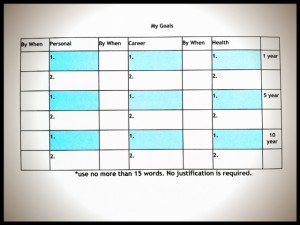Ready to start setting your goals?
Awesome! Here’s a worksheet to get you started:
STEP #1: VISION OF YOUR LIFE:
Your age now:
Your age in 10 years:
Your ideal life: Write 2-3 sentences next to each of the following headings about where you would like to see yourself in 10 years:
Career:
Income:
Net Worth:
Home(s):
Geography (where you live):
Lifestyle:
Health (are you running marathons? Maintaining a certain weight? Taking vacation time seriously?):
Family:
Relationship:
Education:
What are your core values? Pick 3 for this list or add your own:
Creativity, knowledge, responsibility, growth, development, family, quality, balance, courage, achievement, patience, loyalty, legacy, integrity, wealth, greatness, recognition, health, passion, fun, leadership, commitment
STEP #2: YOUR GOALS
Now that you have a better understanding of the things you want in your life, you can start writing out some specific goals.
Take a piece of paper and replicate the following box on your page:
Have a read through this worksheet, but before you get started, check out these goal setting tips I’ve learned along the way. I’ve filled out this sheet many a time!!
TIP #1: Your goals are where your powerful to do lists come from.
For example, a powerful goal could sound something like: I run a 3hr15min marathon by June 1, 2014.
The to do list is how you will achieve that goal, and could look something like this:
Week 1
I get a running coach who agrees to train me once a week.
I run a total of 30 miles by the end of the week.
I do 100 ab exercises this week.
I buy a good pair of running shoes.
I start a nutrition plan.
The list can go on. The bottom line is that your to do list is comprised of mini goals that help to get you to your ultimate goal. But without an ultimate goal in mind, the to do list is a moot exercise.
TIP #2: Start with your 10 year vision and trickle back from there.
What will you have to do in 5 years to get to your 10 year goal? What will you have to do next year to get to your 10 year goal? This makes the 10 year goal seem much more attainable, because you can take it in baby steps.
Example:
I own 100 profitable bakeries across North America by June 2022.
That means that in 5 years, I should probably own 50 profitable bakeries in the USA, and have opened my first Canadian one by June 2017.
That means that in 1 year, I probably own 10 profitable bakeries in California, Texas and New York.
Don’t forget – my to-do list is going to be focused on attaining these goals, and will likely include things like:
I interview 10 successful bakery owners to get advice on how to run a successful bakery.
I take out a loan to open my second bakery or I have raised enough money to do so.
I hire a general manager.
Etc.
TIP #3: Set goals in the present tense.
There is something much more powerful in saying: I AM a doctor by June 2015 vs. saying I would like to be a doctor by June 2015.
Present tense helps the subconscious to go to work immediately on making your goal a reality, giving you motivation and inspiration, and helping you to see things you might not otherwise see.
TIP #4: Use powerful language.
I AM.
I DO.
I WILL.
These are powerful ways to state a goal.
I WISH…
I HOPE TO…
I WILL TRY…
I WOULD LIKE TO…
I PROBABLY WILL…
These are very wishy washy ways to state a goal, and they represent hesitation and fear. They are also self fulfilling prophecies. If you hope for something, you are putting “hope” out into the universe and most of the time, that is all you will get back. If you ARE something, you are putting that out into the universe, and most of the time, that is what you will get back.
TIP #5: Set by-whens.
If there is no set deadline by which to achieve a goal, because our lives are so busy, we almost certainly will never achieve the goal. Life gets busy, other things come up, and the goal gets pushed further and further back until it is either not achieved at all, or not achieved anywhere near the time we had hoped it would be.
Setting a deadline also does is help to focus your to-do lists.
Example:
I run my first IronMan by October 2014.
This means that I better have training runs, swims and bike rides in my weekly to do lists starting now!
So – be as specific as possible and set a deadline for the completion of your goals. If you find that the goal date you originally associated with a particular goal is coming up, and you realize the goal will not be accomplished, simply re-set the deadline and re-commit to the new date.
TIP #6: Set SMART goals.
S – specific – the more specific you are, the more likely it is that you will achieve your goal.
M – measurable – we need to be able to measure our goals so we know if we’ve achieved them! For example, if my goal is to lose weight, how can I measure that? How can I be motivated by that? We need goal posts! A more powerful goal would be to say: I weigh 140lbs by June 2012. Once I reach that goal, I can then say: I weigh 135lbs by August 2012. When I have a goal weight in mind, it is much more likely that I will achieve it, because I know where I stand, and where I want to go.
A – attainable – For the purposes of this exercise, attainable and realistic will go hand in hand. We want to set goals that challenge us, scare us, and really push us to the next level. That said, we need to make sure they are within our realm of possibility. For example, I am Canadian, therefore I cannot have a goal to be the president of the USA. It will never be in the realm of my possibility because of my birth certificate. So please do not take this “attainable and realistic” piece to mean that you should not shoot for the stars. Just make sure you’re aiming somewhere you can realistically get to.
R – Realistic – see attainable
T – timely – We need to make sure we’re setting goals with realistic time lines. Give yourself some credit. If your goal is to lose 5lbs, don’t give yourself an entire year to do it!! You know you can do it in 1-3 months, so set your deadline in that timely fashion.
TIP #7: Choose positive language
There is a big difference in the following goals:
I lose 10lbs by June 2015 vs. I weigh 140lbs by June 2015.
I don’t smoke vs. I am a non-smoker by August 2012.
Which one sounds more powerful to you?
TIP #8: Remember: your goals can – and probably will – change.
So 10 years ago you wanted to be a Rockette at Radio City Music Hall. But 5 years into that goal you no longer had the passion for it. That’s ok! The point in setting goals is simply to set them so you can move in the direction of something that inspires you. If you don’t try it, you won’t know if you like it or not. It’s like trying on clothes – sometimes something that looks great on the mannequin or someone else either looks just as fabulous on you, or not so fabulous at all. When it comes to goals, give yourself a break! If something doesn’t work out or you simply don’t want to do something anymore, change course, reset your goals, and try, try again. And once you’ve achieved the goals you set out to achieve, guess what? It’s time to make a whole new set of goals. It’s a world of possibilities out there, friends – your world! Dare to dream big, reach high, and never settle for less.








